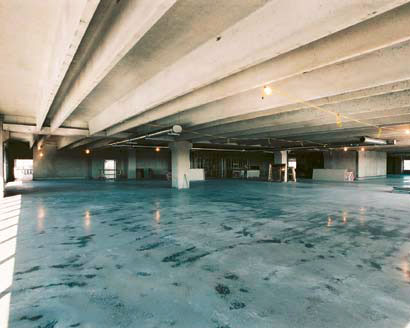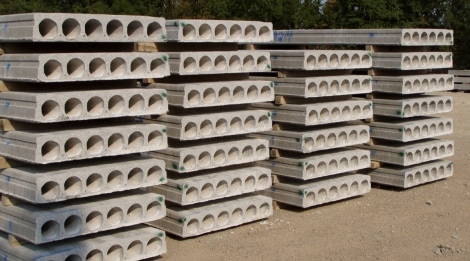Floors are the key element when it comes to architectural freedom and design. Their load bearing capacity has a direct influence on the need for partition walls and other structural elements of a building. Double tees and hollowcore or solid slabs are prestressed floor elements. The excellent loadbearing capacity and structural efficiency allows you to build large areas with fewer partition walls. Ultimately, this means greater freedom in design and savings in material costs.
Double Tees
Named for its shape, double tees are used primarily as floor and roof deck components for any type of structure, including parking structures and all types of buildings. They are made either:
Pre-topped using a flange thickness of 4 in., which creates the wearing surface in parking structures; or
Field-topped with a 2-in. flange, on which a cast-in-place concrete composite topping of 2 to 4 in. is added in the field. For roof construction, there is typically no need to add topping on the 2 in. flange.
Typical widths: 8, 10, 12, and 15 ft.
Typical depths: 24, 26, 28, 30, 32, and 34 in.
Typical span-to-depth ratios: Floors: 25 to 35 / Roofs: 35 to 40
Finishes: Form side will mainly be “as cast,” resulting in a smooth, hard finish. This generally remains as is and is not painted, although it can be if desired. The top-of-flange side will be smoothed for roof construction, left rough if it will receive a field topping or broomed (either transversely or longitudinally), or circular swirl-finished if it will be used as the wearing surface in a parking structure.
Hollow-core
Hollow-core slabs are used predominantly for floor and roof deck components for various structures such as residential, hotel, office buildings, schools, and prisons.
Typical widths: 2, 4, and 8 ft; some precast producers offer 10 and 12 ft widths
Typical depths: 6, 8, 10, 12, 15, and 16 in.
Typical span-to-depth ratios: Floors: 30 to 40 / Roofs: 40 to 50
Note: Each producer of hollow-core slabs uses a trademarked process that creates different shapes to form the voids within the pieces. Information on the key types of hollow-core and the signature shapes produced by each process can be found in the PCI Design Handbook 7th Edition. Load tables and span charts can be found under Design Resources.
Solid Slabs
Solid slabs are used as structural deck components similar to hollow-core slabs. They can be made in a long-line pre-tensioning facility and reinforced with prestressing strand or cast in individual forms with either prestressing strand or conventional reinforcing bars. They are typically cast in the same position as used in the structure.
Sizes can vary to satisfy the structural requirements.
Typical widths: 4 to 12 ft.
Typical spans: 8 to 30 ft.
Typical thicknesses: 4 to 12 in.
Finishes: The form side (bottom) is smooth as cast and typically will remain that way in the finished construction. When it is an exposed surface, it can remain as is or painted without additional treatment. The top side is troweled to the desired degree of smoothness or may be intentionally roughened to receive a cast-in-place concrete topping that will act compositely and provide additional strength.
Precast Structural Systems
To learn more about precast structural systems and how they work, as well as integration with other systems, visit Building Engineering Resources.






